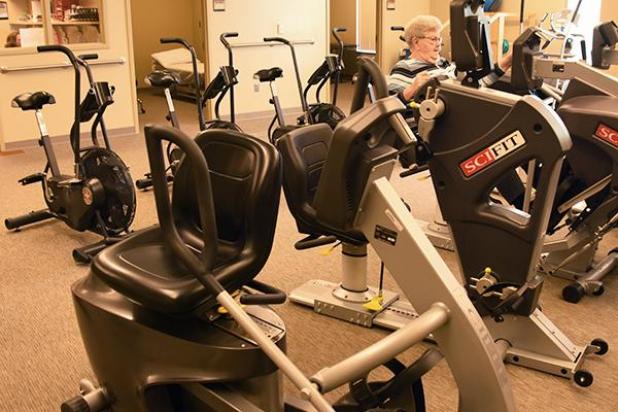
Sharing space with cardiac rehab, the physical therapy department at Melissa Memorial Hospital utilizes equipment that ranges from simple elastic resistance bands to big ticket items like recumbent ellipticals and steppers. — The Holyoke Enterprise | Johnson Publications
Health care has emerged as the nation’s largest employer
Historically, the United States job force has been led by careers in manufacturing and retail. It’s a sign of the times that last year, the health care sector moved to the lead for the first time ever. Life expectancy is longer and the population of the country is aging, which means the demand for health care services has increased.
It’s also a largely subsidized industry due to things like Medicare and Medicaid as well as benefits for veterans and people with government jobs. And unlike many of the manufacturing or retail jobs out there, health care can’t really be outsourced.
The growth of health care jobs doesn’t look to be slowing down anytime soon either. According to the Bureau of Labor Statistics, total employment is projected to grow to 167.6 million jobs in 2026. That would be up by 11.5 million jobs since 2016. About one-third — 4 million — of those new jobs are expected to be in the health care and social assistance sector.
Looking at the BLS list of the 20 fastest growing occupations for that decade-long span, half are health-related. Among those, there’s another noticeable pattern: several are in the fields of physical therapy and occupational therapy. Physical therapist assistants came in eighth, followed by physical therapist aides at 11th, occupational therapy assistants 15th and physical therapists 17th.
Their expected growth rates range from 28 percent to 31 percent.
This data from the BLS is used by high school and college students, advisers, guidance counselors and people looking for jobs. Those looking to fill one of those new PT/OT jobs may find insight from professionals within the field helpful.
Melissa Memorial Hospital’s two full-time therapy staff have a combined 67 years of experience in the industry and answered several questions about their field of work.
With a slightly different perspective working with residents at Regent Park nursing home, director of rehab and physical therapist assistant Jesse Madl also weighed in.
What’s the difference between PT and OT?
Leah Hoyer is the physical therapist at MMH, and Jill Pelster is the physical therapist assistant. Though neither work in occupational therapy, they emphasized that PT and OT go hand in hand. Many patients end up utilizing both — even for the same injury or condition.
Hoyer explained that PT aims to optimize people’s function. There isn’t a one-size-fits-all treatment, but PT focuses mainly on mobility. Something they often see in the MMH physical therapy department is patients recovering from total joint replacements. PT can help them get out of bed, move around and walk.
On the OT side, Hoyer said people can be confused by the word “occupational.” She explained it as the “occupation of life.” OT focuses on activities of daily living. That same total joint replacement patient might work on dressing themselves, bathing, using the bathroom or preparing meals with an occupational therapist.
The PT gets them moving, and the OT helps them complete daily tasks.
Occupational therapists also specialize in fine motor skills. For that reason, Hoyer explained, she typically refers patients to OT when improving hand function is the goal. At MMH, Hoyer and Pelster do physical therapy full time, but if OT is needed, an occupational therapist from North Platte, Nebraska, is contracted.
A third branch of therapy that didn’t show up in the list of fastest growing jobs is speech therapy. It can come into play for speaking needs, of course, but also for swallowing. At MMH, a speech therapist from Dundy County, Nebraska, is contracted as necessary.
Likewise, Madl’s position at Regent Park is supplemented by several other individuals. A speech therapist from Denver is employed by the nursing home to work there a couple of times a week. A physical therapist is contracted to supervise Madl and do evaluations. An occupational therapist as well as a certified occupational therapy assistant are on contract to meet the OT needs of the residents too.
Regent Park depends on therapists and assistants who work for travel companies as it can be difficult to find employees to fill such roles in remote towns like Holyoke. They work on 13-week contracts, with some extending repeatedly up to a year.
Therapist, assistant, aide — what do they do?
To become a physical therapist, a doctorate is required. Similarly, the American Occupational Therapy Association has a goal that by 2025, a professional degree will be necessary to become an occupational therapist.
Becoming a therapist has a large up-front time commitment, Hoyer said. Those interested in becoming one should expect a minimum of six years to do so, between earning a bachelor’s degree and completing a doctor of physical therapy program.
An assistant is still a certified position, but less schooling is required. Pelster, for example, got into the career with an associate degree.
As for responsibilities, the two explained, the therapist does an initial evaluation, looking at the whole body system. She will set goals, determine what is the most ideal program and establish a treatment plan. At that point, the patient is turned over to the assistant to carry out the actual treatment.
The full article is available in our e-Edition. Click here to subscribe.
